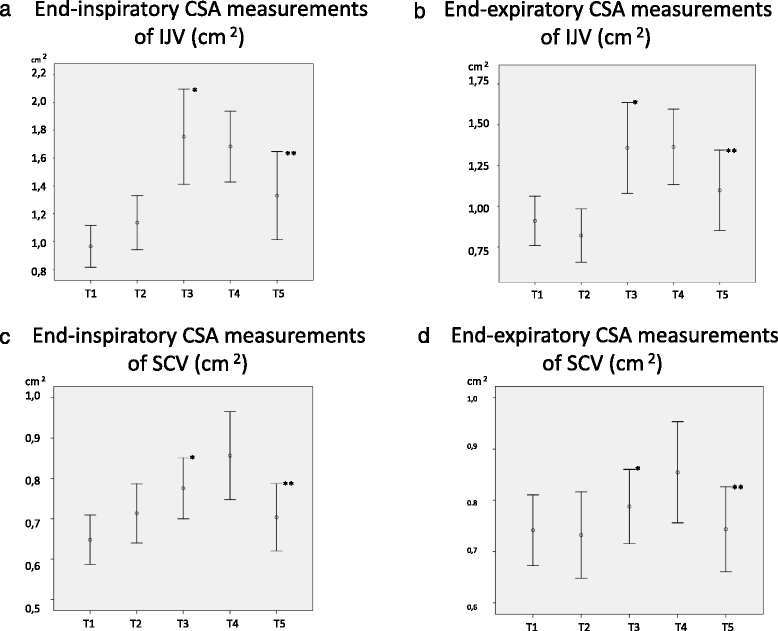The effect of pneumoperitoneum on the cross-sectional areas of internal jugular vein and subclavian vein in laparoscopic cholecystectomy operation
- PMID: 27515323
- PMCID: PMC4982326
- DOI: 10.1186/s12871-016-0226-x
The effect of pneumoperitoneum on the cross-sectional areas of internal jugular vein and subclavian vein in laparoscopic cholecystectomy operation
Abstract
Background: Increased central venous pressure secondary to an increase in intraabdominal pressure has been reported during laparoscopic surgery. However, no study has yet determined the effect of pneumoperitoneum on cross-sectional area (CSA) of central veins by ultrasonography during laparoscopic cholecystectomy. Herein, we aimed to quantify changes in CSAs of internal jugular (IJV) and subclavian veins (SCV) by ultrasonography during this surgery.
Methods: This study included 60 ASA I-II patients scheduled for laparoscopic cholecystectomy surgery under general anesthesia. Pneumoperitoneum was performed with CO2 at 12 mmHg. The CSAs of right IJV and right SCV were measured using a 6 Mhz ultrasonography transducer in supine and neutral positions before anesthesia induction (T1), 5 min after connecting to mechanical ventilator (T2), 5 min after creation of pneumoperitoneum (T3), at the end of pneumoperitoneum (T4), and 5 min after desufflation and before extubation (T5) both at end-expiration and end-inspiration.
Results: The comparison of IJV CSA at inspiration showed significant increase in T3 value compared to T2 value (p < 0.001). Similarly the expiratory measurements of IJV CSA demonstrated significant increase in T3 value compared to T2 value (p < 0.001). The comparison of inspiratory CSA measurements of SCV showed significantly increased in T3 (p = 0.009) than T2 value. In expiratory measurements there was a significant increase in T3 (p = 0.032) value compared to T2. All measurements of IJV and SCV SCAs both end-inspiration and end-expiration T5 values significantly decreased compared to T4 values (p < 0.001).
Conclusions: Pneumoperitoneum with an intraabdominal pressure of 12 mmHg produces significant increases in IJV and SCV CSAs during laparoscopic cholecystectomy procedure. We believe that this finding may enhance our understanding of pneumoperitoneum-induced hemodynamic changes and facilitate catheterization attempts.
Trial registration: Date of registration 21/07/2016, ISRCTN Registry ( No: ISRCTN15164056 , registered retrospectively).
Figures


Similar articles
-
The effect of different pressures of pneumoperitoneum on the dimensions of internal jugular vein - A prospective double-blind, randomised study.Indian J Anaesth. 2022 Sep;66(9):631-637. doi: 10.4103/ija.ija_350_22. Epub 2022 Sep 20. Indian J Anaesth. 2022. PMID: 36388446 Free PMC article.
-
Effect of various pneumoperitoneum pressures on femoral vein hemodynamics during laparoscopic cholecystectomy.Updates Surg. 2016 Jun;68(2):163-9. doi: 10.1007/s13304-015-0344-x. Epub 2016 Feb 5. Updates Surg. 2016. PMID: 26846295 Clinical Trial.
-
Complications in internal jugular vs subclavian ultrasound-guided central venous catheterization: a comparative randomized trial.Intensive Care Med. 2019 Jul;45(7):968-976. doi: 10.1007/s00134-019-05651-9. Epub 2019 May 29. Intensive Care Med. 2019. PMID: 31143996 Clinical Trial.
-
Comparing internal jugular vein and subclavian vein for central venous insertion of implantable ports in cancer chemotherapy: a meta-analysis of RCTs.Front Oncol. 2025 May 26;15:1566757. doi: 10.3389/fonc.2025.1566757. eCollection 2025. Front Oncol. 2025. PMID: 40492120 Free PMC article.
-
Prevention of postoperative venous thromboembolism following laparoscopic cholecystectomy.Surg Endosc. 1994 Jul;8(7):741-7. doi: 10.1007/BF00593432. Surg Endosc. 1994. PMID: 7974098 Review.
Cited by
-
The effect of different pressures of pneumoperitoneum on the dimensions of internal jugular vein - A prospective double-blind, randomised study.Indian J Anaesth. 2022 Sep;66(9):631-637. doi: 10.4103/ija.ija_350_22. Epub 2022 Sep 20. Indian J Anaesth. 2022. PMID: 36388446 Free PMC article.
References
-
- Rebecca AS, Atilio B, Shahar B, Jonathan BM. Cardiovascular monitoring. In: Miller RD, editor. Miller’s Anesthesia. 7. Philadelphia: Elsevier Churchill Livingstone; 2009. pp. 1285–1328.
-
- Lobato E, Florete OG, Paige GB, Morey TE. Cross-sectional area and intravascular pressure of the right internal jugular vein during anesthesia: Effects of trendelenburg position, positive intrathoracic pressure, and hepatic compression. J Clin Anesth. 1998;10:1–5. doi: 10.1016/S0952-8180(97)00189-X. - DOI - PubMed
Publication types
MeSH terms
LinkOut - more resources
Full Text Sources
Other Literature Sources

